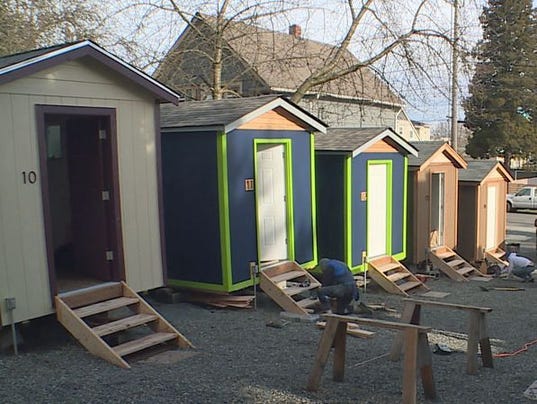
RENO — A coalition of faith-based and human services groups is working to build a tiny house village for the homeless in Reno, but they need money and land.
They
would also need the city of Reno to change its zoning and building code
laws to allow for such homes to be built without bathrooms, kitchens or
other code requirements that other builders are held to.
At
the Reno City Council meeting Wednesday, Pat Cashell of Volunteers for
America and Sharon Chamberlain of Northern Nevada HOPES presented their
ideas for a tiny home village to help house the chronically homeless.
The
plan is modeled after similar villages in Seattle; Portland, Ore.; and
Eugene, Ore. It would include 40 bare-bone houses that one councilwoman
likened to a "tent with hard walls," including a roof and a locking
door. The houses would be situated around a central building with
bathrooms and kitchen facilities.
More: Drake University teams up with Joppa to build tiny homes for Des Moines' homeless
More: This 13-year-old built his own tiny house for $1,500, and you can too
More: Homeless children sniff glue to take 'away the pain' of surviving Somalia's streets
Cashell
said the group would count on volunteers from youth groups, church
groups and other community members to donate supplies and labor. He
estimated each house would cost about $3,800 to build.
Chamberlain
estimated the project would need a $270,000 operating budget, which
would fund a project manager and case managers who could help connect
residents to other social services and permanent housing.
The
village would help close a housing gap that is widening as Reno comes
to grips with an economic recovery that is driving housing prices up and
vacancy rates down.
Human services agencies have
seen wait times triple as they try to find transitional housing for
chronically homeless individuals who can't make use of the shelter
because they have a partner, a pet or a health condition that puts the
shelter out of their reach.
Cashell, who spent 10 years homeless as he battled addiction, stressed such a project is critical.
"People without shelter die," he said. "I can’t stress this enough. These are human beings who actually die."
The group is on the hunt for land and has its eye on three parcels already owned by the city of Reno.
The
city is already considering a second homeless shelter. Councilman Paul
McKenzie suggested both the shelter and the tiny home village could be
built on the same site.
Councilwoman Neoma Jardon
has been pushing for a tiny home project, saying she'd like to see it
get off the ground within 90 days.
"The homeless shelter is full and the overflow shelter is overflowing," she said.
That could be difficult, however. Reno's building and zoning codes don't allow for such dwelling units.
Originally published on https://www.usatoday.com/story/news/nation-now/2017/10/12/tiny-houses-arent-just-millennials-they-could-help-homeless/756955001/
